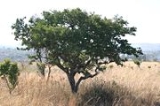
Strychnos pungens
Encyclopedia
Strychnos pungens is a tree which belongs to the Loganiaceae
. Usually about 5m tall, occurring in mixed woodland or in rocky places. Branches are short and rigid. Leaves are smooth, stiff, opposite, elliptic and with a sharp, spine-like tip. Occurring in South Africa
on the Witwatersrand
, Magaliesberg
and further north to northern Namibia
, northern Botswana
and Zimbabwe
.
The fruit is large (120mm diameter), round and with a smooth hard shell, bluish-green in colour and turning yellow when ripe. The pulp of ripe fruit is rich in citric acid
and is edible, but the seeds are mildly poisonous. The tree is a close relative of Strychnos nux-vomica
, the source of strychnine
.
Loganiaceae
Loganiaceae are a family of flowering plants classified in order Gentianales. The family includes 13 genera, distributed around the world's tropics.Earlier treatments of the family have included up to 29 genera...
. Usually about 5m tall, occurring in mixed woodland or in rocky places. Branches are short and rigid. Leaves are smooth, stiff, opposite, elliptic and with a sharp, spine-like tip. Occurring in South Africa
South Africa
The Republic of South Africa is a country in southern Africa. Located at the southern tip of Africa, it is divided into nine provinces, with of coastline on the Atlantic and Indian oceans...
on the Witwatersrand
Witwatersrand
The Witwatersrand is a low, sedimentary range of hills, at an elevation of 1700–1800 metres above sea-level, which runs in an east-west direction through Gauteng in South Africa. The word in Afrikaans means "the ridge of white waters". Geologically it is complex, but the principal formations...
, Magaliesberg
Magaliesberg
The Magaliesberg is a mountain range extending from Pretoria in the north of the Gauteng Province to a point south of Pilanesberg, in the North West Province, South Africa...
and further north to northern Namibia
Namibia
Namibia, officially the Republic of Namibia , is a country in southern Africa whose western border is the Atlantic Ocean. It shares land borders with Angola and Zambia to the north, Botswana to the east and South Africa to the south and east. It gained independence from South Africa on 21 March...
, northern Botswana
Botswana
Botswana, officially the Republic of Botswana , is a landlocked country located in Southern Africa. The citizens are referred to as "Batswana" . Formerly the British protectorate of Bechuanaland, Botswana adopted its new name after becoming independent within the Commonwealth on 30 September 1966...
and Zimbabwe
Zimbabwe
Zimbabwe is a landlocked country located in the southern part of the African continent, between the Zambezi and Limpopo rivers. It is bordered by South Africa to the south, Botswana to the southwest, Zambia and a tip of Namibia to the northwest and Mozambique to the east. Zimbabwe has three...
.
The fruit is large (120mm diameter), round and with a smooth hard shell, bluish-green in colour and turning yellow when ripe. The pulp of ripe fruit is rich in citric acid
Citric acid
Citric acid is a weak organic acid. It is a natural preservative/conservative and is also used to add an acidic, or sour, taste to foods and soft drinks...
and is edible, but the seeds are mildly poisonous. The tree is a close relative of Strychnos nux-vomica
Strychnine tree
The Strychnine tree also known as Nux vomica, Poison Nut, Semen strychnos and Quaker Buttons, is a deciduous tree native to India, southeast Asia, a member of family Loganiaceae. It is a medium-size tree growing in open habitats...
, the source of strychnine
Strychnine
Strychnine is a highly toxic , colorless crystalline alkaloid used as a pesticide, particularly for killing small vertebrates such as birds and rodents. Strychnine causes muscular convulsions and eventually death through asphyxia or sheer exhaustion...
.

